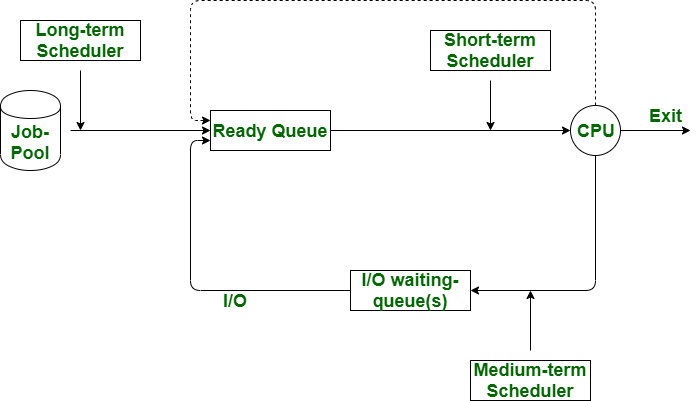先决条件 – 进程调度程序
长期调度程序:
长期调度程序称为作业调度程序。长期调度程序控制在系统内选择进行处理的程序。在这种情况下,程序在队列中被发现,因此根据需要选择最好的一个作业,它从作业池中选择进程并将这些进程加载到内存中以执行。它提供了对多道程序程度的限制。
中期调度程序:
中期调度程序称为进程交换调度程序,因为它是交换的一部分。通过这个调度程序,进程从内存中删除。中期调度器减少了多道程序的程度。在这个调度程序中,如果一个进程请求 I/O,它可以被挂起,并且它不能在完成挂起的进程方面取得任何进展。在这种情况下,为了从内存中清除该方法并为其他进程腾出空间,将挂起的进程移动到辅助存储中。此过程称为交换,因此声称该过程已被换出或展开。交换也可能是必要的,以增强工艺组合。

让我们看看 Long-Term 和 Medium-Term Scheduler 之间的区别:
| S.NO | Long-Term Scheduler | Medium-Term Scheduler | |||
|---|---|---|---|---|---|
| 1. | Long-term scheduler is called as job scheduler. | Whereas medium-term scheduler is called as process swapping scheduler. | 2. | In long-term scheduler, the process are selected from the job pool and these process are loaded into memory in order to execute. | While in this, process can be revived in the memory as well as process execution can also be carried out. |
| 3. | Long-term scheduler is can be or can’t be a part of a time sharing system. if it is then it is a nominal in time sharing system. | While medium-term scheduler is always in a time sharing system. | |||
| 4. | The speed of long -term scheduler is less than medium-term scheduler. | While the speed of medium -term scheduler is comparatively higher than longer-term scheduler. | |||
| 5. | Long-term scheduler provides the restraint on the DOM(Degree of Multi-programming). | While medium-term scheduler cut down the degree of DOM(Degree of Multi-programming). |